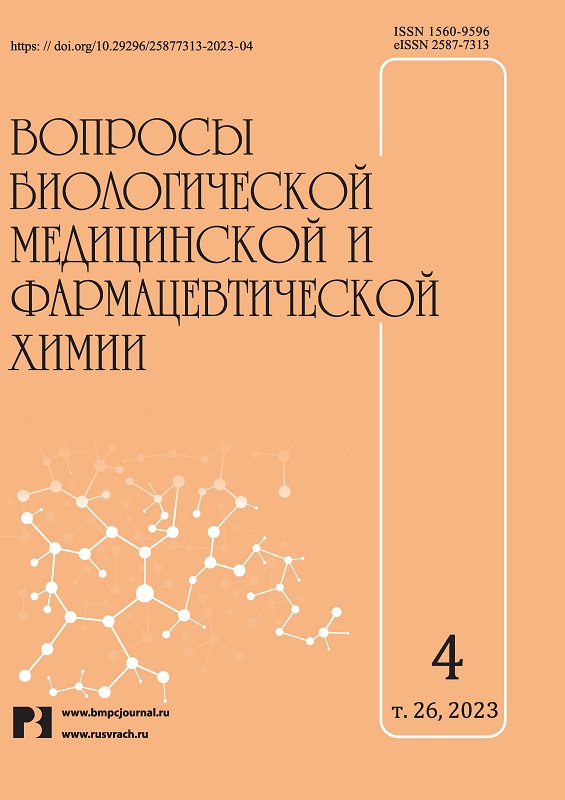Relationship between biochemical indicators and phenotypical features of garden savory (satureja hortensis l.)
- 作者: Malankina E.L.1, Solopov S.G.1, Romanova N.G.2
-
隶属关系:
- Russian State Agrarian University – Moscow Timiryazev Agricultural Academy
- State Budgetary Professional Education Institution of the Health Care Department of Moscow «MEDICAL COLLEGE № 2»
- 期: 卷 26, 编号 4 (2023)
- 页面: 10-15
- 栏目: Pharmaceutical chemistry
- URL: https://journals.eco-vector.com/1560-9596/article/view/340932
- DOI: https://doi.org/10.29296/25877313-2023-04-02
- ID: 340932
如何引用文章
详细
Relevance. Garden savory (Satureja hortensis L.) is an annual medicinal plant of interest due to the content of essential oil and phenolic compounds, the content of which varies depending on the variety. Identification of the relationship between morphological and biochemical traits will make the selection of productive plants more effective and accelerated.
The purpose of the study is to identify the phenotypic characteristics of garden savory plants, indicating a high content of certain pharmacologically significant compounds or their groups.
Materials and methods. The 9 samples of garden savory served as the object of the study. The content of essential oil was determined in dry raw materials by hydrodistillation according to Clevenger, the component composition was determined by gas chromatography. The flavonoid content was determined in terms of rutin was carried out in terms of rutin, the amount of phenolic compounds and tannins in terms of gallic acid.
Results: Early maturing varieties are characterized by a high content of essential oil (r = 0.685) with a low content of tannins
(r = –0.69). There was a relationship between the leaf index and the content of tannins (r = 0.620), with the accumulation of flavonoids (r = –0.522), with the content of γ-terpinene in the essential oil (r = 0.77) and of carvacrol (r = –0.76).
The presence of anthocyanin coloration is interconnected with the content of essential oil (r = –0.688) and content of carvacrol in it
(r = –0.53), with the content of the sum of flavonoids (r = 0.598), gamma terpinene (r =0.541) and tannins (r = 0.7).
Conclusion. The identified phenotypic features of garden savory plants indicate a high content of certain pharmacologically significant compounds or their groups. Thus, is shown the selecting possibility of prospective plants according to external features.
全文:
作者简介
E. Malankina
Russian State Agrarian University – Moscow Timiryazev Agricultural Academy
编辑信件的主要联系方式.
Email: gandurina@mail.ru
Dr.Sc. (Agric.), Professor of the Vegetable Growing Department
俄罗斯联邦, MoscowS. Solopov
Russian State Agrarian University – Moscow Timiryazev Agricultural Academy
Email: gandurina@mail.ru
Ph.D. (Agric.), Department of Vegetable Growing
俄罗斯联邦, MoscowN. Romanova
State Budgetary Professional Education Institution of the Health Care Departmentof Moscow «MEDICAL COLLEGE № 2»
Email: gandurina@mail.ru
Ph.D. (Agric.), Associate Professor
俄罗斯联邦, Moscow参考
- Malankina E.L., Tkachjova E.N., Al' Karavi H. i dr., Kozlovskaja L.N. Var'irovanie biohimicheskih pokazatelej syr'ja tim'jana polzuchego (Thymus serpyllum L.) v zavisimosti ot sorta. Voprosy biologicheskoj, medicinskoj i farmacevticheskoj himii. 2018; 21(7): 11–15.
- Wang B., Ma L., Yin, L. et al. Regional variation in the chemical composition and antioxidant activity of Rosmarinus officinalis L. from China and the Mediterranean re-gion. Pak. J. Pharm. Sci. 2018; 31, 221–229. doi: 10.29296/25877313-2018-07-03.
- Melito S., Petretto G.L., Chanhine S., et al. Seasonal variation of essential oil in Rosmarinus officinalis leaves in Sardinia. Nat. Prod. Comm. 2019; 14: 1–7.
- Mohammad Hassanzadeh-Khayyat, Mohammad Rahimizadeh, Masoumeh Azadi, Amirhossein Sahebkar. Phytochemical Analysis of Satureja hortensis L. Essential Oil from Iran. Analytical Chemistry Letters. 2012; 2(Issue 3): 192–197. https://doi.org/10.1080/22297928.2000.10648269.
- Malankina E.L., Kozlovskaja L.N., Solopov S.G. i dr. Osobennosti komponentnogo sostava jefirnogo masla chabera sadovogo (Satureja hortensis l.) v zavisimosti ot sorta. Izvestija Timirjazevskoj sel'skohozjajstvennoj akademii. 2017; 3: 19–29.
- Boyraz N., Ozcan M. Inhibition of phytopathogenic fungi by essential oil, hydrosol, ground material and extract of summer savory (Satureja hortensis L.) growing wild in Turkey. Int. J. Food Microbiol., 2006; 107: 238–242.
- Mihajilov-Krstev T., D. Radnović, D. Kitić, B. Zlatković et al. Chemical composition and antimicrobial activity of Satureja hortensis L. essential oil. Cent. Eur. J. Biol. 2009; 4(3): 411–416. doi: 10.2478/s11535-009-0027-z.
- Ben Arfa A., Combes S., Preziosi-Belloy L., et al. Antimicrobial activity of carvacrol related to its chemical structure, Lett. Appl. Microbiol. 2006; 43: 149–154.
- Lohwasser U., Boerner A., Novak J. Screening der Gatersleben Rosmarin-Kollektion 23. Bernburger Winterseminar Arznei- und Gewuerzpflanzen, 20.02-21.02.2018. Bernburg. 2018; 21–23.
- Rukovodstvo po metodam kontrolja kachestva i bezopasnosti biologicheski aktivnyh dobavok k pishhe R 4.1.1672-03. M., 2004.
- Metody analiza minornyh biologicheski aktivnyh veshhestv pishhi. Pod red. V.A. Tutel'jana i K.I. Jellera. M.: Dinastija. 2010; 60 s.
补充文件





